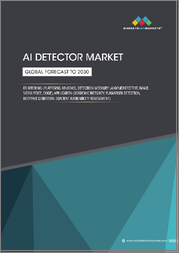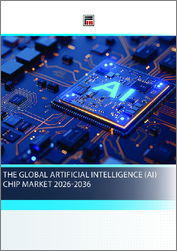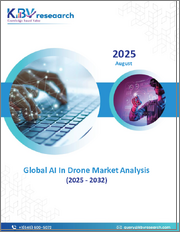
|
시장보고서
상품코드
1570689
세계의 AI 오케스트레이션 시장 : 컴포넌트별, 용도별, 기술별, 전개 유형별, 조직 규모별, 최종 사용자별 - 예측(2025-2030년)AI Orchestration Market by Component (Services, Solutions), Application (Data Integration, Process Automation, Resource Scheduling), Technology, Deployment Type, Organization Size, End-User - Global Forecast 2025-2030 |
||||||
AI 오케스트레이션 시장은 2023년에 78억 1,000만 달러로 평가되었고, 2024년에는 92억 4,000만 달러로 추정되며, CAGR 19.94%로 성장할 전망이고, 2030년에는 279억 1,000만 달러에 달할 것으로 예상됩니다.
AI 오케스트레이션은 여러 AI 시스템과 프로세스를 통합, 관리, 자동화하고 조직 내에서 조화롭게 작동하며 이러한 종합적인 성능을 최적화하는 프로세스를 말합니다. 서로 다른 AI 기술과 데이터 소스 간의 원활한 상호 작용을 가능하게 하고 업무 사일로화를 줄이기 위해 AI 도입의 효율성과 효율성을 극대화하는 데 매우 중요합니다. AI 오케스트레이션의 필요성은 AI 프로세스를 간소화하고, 확장성을 높이고, 시장 출시 시간을 단축하는 능력에 있으며, 금융, 의료, 소매, 제조와 같은 데이터 집약적인 업계에서 특히 필수적입니다. 워크플로우의 자동화, 의사결정 정밀도의 향상, 다양한 AI 모델의 연계에 의한 혁신의 촉진 등에 응용되어 데이터별 종합적인 인사이트로 이어집니다. 주요 성장 요인으로는 클라우드 기반 솔루션 채택 증가, AI 및 머신러닝에 대한 수요 증가, 효율적인 프로세스 자동화 필요성, 데이터 생성량의 급격한 증가 등이 있습니다. 시장 확대 기회는 기업이 경쟁 우위를 위해 통합된 AI 솔루션을 요구하는 디지털 변환 증가 추세에도 존재합니다. 그러나 통합 복잡성, 데이터 프라이버시 우려, 높은 도입 비용, 상당한 인프라 변경 필요 등의 과제는 시장 성장의 제약이 되고 있습니다. 혁신 기회는 특히 상호 운용 가능한 AI 플랫폼 개발, AI 거버넌스 프레임워크 강화, 에지 AI 기능의 진화에 존재합니다. 기업은 확장성, 상호 운용성 및 프라이버시를 선호하는 견고한 AI 오케스트레이션 도구에 투자함으로써 이들을 활용할 수 있습니다. 시장 과제를 해결하기 위해 하이브리드 AI 오케스트레이션 모델과 데이터 관리 프로토콜의 개선을 탐구하는 조사가 필요합니다. AI 오케스트레이션 시장의 성격은 역동적이고 지속적으로 진화하고 있으며, 그 가능성을 효과적으로 활용하기 위해서는 끊임없는 적응과 혁신적인 전략이 필요합니다. 이러한 변화를 극복하고 경쟁 구도에서 우위를 차지하기 위해서는 경쟁 인사이트과 시장 상황이 필수적입니다.
| 주요 시장 통계 | |
|---|---|
| 기준년(2023년) | 78억 1,000만 달러 |
| 예측년(2024년) | 92억 4,000만 달러 |
| 예측년(2030년) | 279억 1,000만 달러 |
| CAGR(%) | 19.94% |
시장 역학 : 빠르게 진화하는 AI 오케스트레이션 시장의 주요 시장 인사이트 공개
AI 오케스트레이션 시장은 수요 및 공급의 역동적인 상호작용을 통해 변모를 이루고 있습니다. 이러한 시장 역학의 진화를 이해함으로써 기업은 충분한 정보를 바탕으로 투자결정, 전략적 결정 정밀화, 새로운 비즈니스 기회 획득에 대비할 수 있습니다. 이러한 동향을 종합적으로 파악함으로써 기업은 정치적, 지리적, 기술적, 사회적, 경제적 영역에 걸친 다양한 위험을 줄일 수 있으며, 소비자 행동과 제조 비용 또는 구매 추세에 미치는 영향에 대해 더 명확하게 이해할 수 있습니다.
Porter's Five Forces : AI 오케스트레이션 시장을 탐색하는 전략 도구
Porter's Five Forces 프레임 워크는 AI 오케스트레이션 시장 경쟁 구도를 이해하는 중요한 도구입니다. Porter's Five Forces 프레임 워크는 기업의 경쟁을 평가하고 전략적 기회를 탐구하는 명확한 기술을 설명합니다. 이 프레임 워크는 기업이 시장 내 세력도를 평가하고 신규 사업의 수익성을 결정하는 데 도움이 됩니다. 이러한 인사이트를 통해 기업은 자사의 강점을 활용하고 약점을 해결하고 잠재적인 과제를 피할 수 있으며 보다 강인한 시장에서의 포지셔닝을 확보할 수 있습니다.
PESTLE 분석 : AI 오케스트레이션 시장에서 외부 영향 파악
외부 거시 환경 요인은 AI 오케스트레이션 시장의 성과 역학을 형성하는데 매우 중요한 역할을 합니다. 정치적, 경제적, 사회적, 기술적, 법적, 환경적 요인 분석은 이러한 영향을 탐색하는 데 필요한 정보를 설명합니다. PESTLE 요인을 조사함으로써 기업은 잠재적인 위험과 기회를 더 잘 이해할 수 있습니다. 이 분석을 통해 기업은 규제, 소비자 선호, 경제 동향의 변화를 예측하고 앞으로 예상되는 적극적인 의사 결정을 할 준비를 할 수 있습니다.
시장 점유율 분석 : AI 오케스트레이션 시장에서 경쟁 구도 파악
AI 오케스트레이션 시장의 상세한 시장 점유율 분석을 통해 공급업체의 성과를 종합적으로 평가할 수 있습니다. 기업은 수익, 고객 기반, 성장률 등 주요 지표를 비교하여 경쟁 포지셔닝을 밝힐 수 있습니다. 이 분석을 통해 시장 집중, 세분화 및 통합 동향을 밝혀내고 공급업체는 경쟁이 치열해지면서 자신의 지위를 높이는 전략적 의사 결정을 내리는 데 필요한 지식을 얻을 수 있습니다.
FPNV 포지셔닝 매트릭스 : AI 오케스트레이션 시장에서 공급업체의 성능 평가
FPNV 포지셔닝 매트릭스는 AI 오케스트레이션 시장에서 공급업체를 평가하는 중요한 도구입니다. 이 행렬을 통해 비즈니스 조직은 공급업체의 비즈니스 전략과 제품 만족도를 기준으로 평가하여 목표에 맞는 충분한 정보를 바탕으로 의사 결정을 내릴 수 있습니다. 네 가지 사분면을 통해 공급업체를 명확하고 정확하게 세분화하여 전략 목표에 가장 적합한 파트너 및 솔루션을 파악할 수 있습니다.
전략 분석 및 추천 : AI 오케스트레이션 시장에서 성공을 위한 길 그리기
AI 오케스트레이션 시장의 전략 분석은 세계 시장에서의 존재를 강화하려는 기업에 필수적입니다. 주요 자원, 능력 및 성과 지표를 검토함으로써 기업은 성장 기회를 파악하고 개선을 위해 노력할 수 있습니다. 이 접근법을 통해 경쟁 구도에서 과제를 극복하고 새로운 비즈니스 기회를 활용하여 장기적인 성공을 거둘 수 있는 체제를 마련할 수 있습니다.
이 보고서는 주요 관심 분야를 포괄하는 종합적인 시장 분석을 제공합니다.
1. 시장 침투도 : 현재 시장 환경에 대해 상세히 검토합니다.
2. 시장 개척도 : 신흥 시장의 성장 기회를 파악하고, 기존 부문에서의 확장 가능성을 평가하며, 미래 성장을 위한 전략적 로드맵을 설명합니다.
3. 시장 다양화 : 최근 제품 출시, 미개척 지역, 업계의 주요 진보, 시장을 형성하는 전략적 투자를 분석합니다.
4. 경쟁 평가 및 정보 : 경쟁 구도를 철저히 분석하고 시장 점유율, 사업 전략, 제품 포트폴리오, 인증, 규제 당국 승인, 특허 동향, 주요 기업의 기술 진보 등을 조사했습니다.
5. 제품 개발 및 혁신 : 미래 시장 성장을 가속할 것으로 예상되는 최첨단 기술, 연구개발 활동, 제품 혁신을 강조합니다.
또한 이해관계자가 충분한 정보를 바탕으로 의사결정을 할 수 있도록 중요한 질문에도 답변하고 있습니다.
1. 현재 시장 규모 및 향후 성장 예측은?
2. 최고의 투자 기회를 제공하는 제품, 지역은 어디입니까?
3. 시장을 형성하는 주요 기술 동향 및 규제의 영향은?
4. 주요 벤더의 시장 점유율 및 경쟁 포지션은?
5. 벤더 시장 진입 및 철수 전략의 원동력이 되는 수익원과 전략적 기회는 무엇인가?
목차
제1장 서문
제2장 조사 방법
제3장 주요 요약
제4장 시장 개요
제5장 시장 인사이트
- 시장 역학
- 성장 촉진요인
- 인간의 개입과 에러를 최소화하는 자동화 솔루션 수요 증가
- 다양한 부문에서의 AI의 이용 증가와 빅 데이터의 급증에 의해 고도의 오케스트레이션 필요
- 억제요인
- 다양한 AI 모델과 레거시 시스템 통합의 어려움
- 기회
- 엣지 디바이스간에 AI 워크플로우를 오케스트레이션하는 성장의 가능성
- 틈새 산업을 위한 맞춤형 오케스트레이션 솔루션 개발
- 과제
- 워크플로우 오케스트레이션의 데이터 거버넌스 및 보안에 대한 우려
- 성장 촉진요인
- 시장 세분화 분석
- 컴포넌트 : 복잡한 AI 시스템을 유지하기 위한 매니지드 서비스에 대한 취향 증가
- 전개 유형 : 확장성을 위해 클라우드 기반 배포 채택 증가
- Porter's Five Forces 분석
- PESTLE 분석
- 정치
- 경제
- 사회
- 기술
- 법률
- 환경
제6장 AI 오케스트레이션 시장 : 컴포넌트별
- 서문
- 서비스
- 매니지드 서비스
- 전문 서비스
- 솔루션
- 통합 툴
- 워크플로우 자동화 툴
제7장 AI 오케스트레이션 시장 : 용도별
- 서문
- 데이터 통합
- 프로세스 자동화
- 로봇식 프로세스 자동화
- 워크플로우 자동화
- 리소스 스케줄링
- 서비스 오케스트레이션
제8장 AI 오케스트레이션 시장 : 기술별
- 서문
- 컴퓨터 비전
- 머신러닝
- 자연언어처리
- 예측 분석
제9장 AI 오케스트레이션 시장 : 전개 유형별
- 서문
- 클라우드 기반
- 하이브리드
- 온프레미스
제10장 AI 오케스트레이션 시장 : 조직 규모별
- 서문
- 대기업
- 중소기업
제11장 AI 오케스트레이션 시장 : 최종 사용자별
- 서문
- 금융
- 부정 행위 검출
- 리스크 관리
- 의료
- 임상 데이터 관리
- 의료비 청구
- 환자 모니터링
- 제조업
- 예지보전
- 공급망 최적화
- 소매
- 고객체험 관리
- 재고 관리
제12장 아메리카의 AI 오케스트레이션 시장
- 서문
- 아르헨티나
- 브라질
- 캐나다
- 멕시코
- 미국
제13장 아시아태평양의 AI 오케스트레이션 시장
- 서문
- 호주
- 중국
- 인도
- 인도네시아
- 일본
- 말레이시아
- 필리핀
- 싱가포르
- 한국
- 대만
- 태국
- 베트남
제14장 유럽, 중동 및 아프리카의 AI 오케스트레이션 시장
- 서문
- 덴마크
- 이집트
- 핀란드
- 프랑스
- 독일
- 이스라엘
- 이탈리아
- 네덜란드
- 나이지리아
- 노르웨이
- 폴란드
- 카타르
- 러시아
- 사우디아라비아
- 남아프리카
- 스페인
- 스웨덴
- 스위스
- 터키
- 아랍에미리트(UAE)
- 영국
제15장 경쟁 구도
- 시장 점유율 분석(2023년)
- FPNV 포지셔닝 매트릭스(2023년)
- 경쟁 시나리오 분석
- TCS, 컴플라이언스, 비용 효율성, 프로토타이핑의 신속화를 실현해 기업의 AI 도입을 합리화하는 AI WisdomNext 발표
- Nvidia, Kubernetes 기반의 고급 오케스트레이션 소프트웨어로 AI 컴퓨팅 기능을 강화하기 위해 Run AI를 7억 달러로 인수
- EPAM은 퍼블릭 LLM과 독자적인 LLM을 융합하여 비즈니스 효율을 향상시키는 DIAL 오케스트레이션 플랫폼 발표
- 전략 분석 및 제안
The AI Orchestration Market was valued at USD 7.81 billion in 2023, expected to reach USD 9.24 billion in 2024, and is projected to grow at a CAGR of 19.94%, to USD 27.91 billion by 2030.
AI Orchestration refers to the process of integrating, managing, and automating multiple AI systems and processes to work harmoniously within an organization, optimizing their collective performance. It is crucial for maximizing efficiency and effectiveness in AI deployment as it enables seamless interaction between different AI technologies and data sources, reducing operational silos. The necessity for AI Orchestration lies in its ability to streamline AI processes, enhance scalability, and reduce time-to-market, making it particularly indispensable in data-intensive industries like finance, healthcare, retail, and manufacturing. It is applied in automating workflows, improving decision-making accuracy, and fostering innovation by encouraging the collaboration of diverse AI models, leading to comprehensive data-driven insights. Key growth factors include the increasing adoption of cloud-based solutions, growing demand for AI and machine learning, need for efficient process automation, and the exponential rise in data generation. Opportunities for market expansion are also present in the growing trend of digital transformation, where businesses seek integrated AI solutions for competitive advantage. However, challenges such as integration complexity, data privacy concerns, high deployment costs, and the need for significant infrastructure changes pose limitations to market growth. Innovation opportunities exist particularly in developing interoperable AI platforms, enhancing AI governance frameworks, and advancing edge AI capabilities. Businesses can capitalize on these by investing in robust AI orchestration tools that prioritize scalability, interoperability, and privacy. Research is needed to explore hybrid AI orchestration models and improved data management protocols to address market challenges. The nature of the AI Orchestration market is dynamic and continuously evolving, demanding constant adaptation and innovative strategies to harness its full potential effectively. Insights and market intelligence are essential for navigating these changes and staying ahead in this competitive landscape.
| KEY MARKET STATISTICS | |
|---|---|
| Base Year [2023] | USD 7.81 billion |
| Estimated Year [2024] | USD 9.24 billion |
| Forecast Year [2030] | USD 27.91 billion |
| CAGR (%) | 19.94% |
Market Dynamics: Unveiling Key Market Insights in the Rapidly Evolving AI Orchestration Market
The AI Orchestration Market is undergoing transformative changes driven by a dynamic interplay of supply and demand factors. Understanding these evolving market dynamics prepares business organizations to make informed investment decisions, refine strategic decisions, and seize new opportunities. By gaining a comprehensive view of these trends, business organizations can mitigate various risks across political, geographic, technical, social, and economic domains while also gaining a clearer understanding of consumer behavior and its impact on manufacturing costs and purchasing trends.
- Market Drivers
- Rising demand for automated solutions to minimize human intervention and errors
- Increasing use of AI across various sectors and proliferation of big data necessitates sophisticated orchestration
- Market Restraints
- Difficulty in integrating diverse AI models and legacy systems
- Market Opportunities
- Growth potential in orchestrating AI workflows across edge devices
- Development of tailored orchestration solutions for niche industries
- Market Challenges
- Concerns over data governance and security while orchestrating workflows
Porter's Five Forces: A Strategic Tool for Navigating the AI Orchestration Market
Porter's five forces framework is a critical tool for understanding the competitive landscape of the AI Orchestration Market. It offers business organizations with a clear methodology for evaluating their competitive positioning and exploring strategic opportunities. This framework helps businesses assess the power dynamics within the market and determine the profitability of new ventures. With these insights, business organizations can leverage their strengths, address weaknesses, and avoid potential challenges, ensuring a more resilient market positioning.
PESTLE Analysis: Navigating External Influences in the AI Orchestration Market
External macro-environmental factors play a pivotal role in shaping the performance dynamics of the AI Orchestration Market. Political, Economic, Social, Technological, Legal, and Environmental factors analysis provides the necessary information to navigate these influences. By examining PESTLE factors, businesses can better understand potential risks and opportunities. This analysis enables business organizations to anticipate changes in regulations, consumer preferences, and economic trends, ensuring they are prepared to make proactive, forward-thinking decisions.
Market Share Analysis: Understanding the Competitive Landscape in the AI Orchestration Market
A detailed market share analysis in the AI Orchestration Market provides a comprehensive assessment of vendors' performance. Companies can identify their competitive positioning by comparing key metrics, including revenue, customer base, and growth rates. This analysis highlights market concentration, fragmentation, and trends in consolidation, offering vendors the insights required to make strategic decisions that enhance their position in an increasingly competitive landscape.
FPNV Positioning Matrix: Evaluating Vendors' Performance in the AI Orchestration Market
The Forefront, Pathfinder, Niche, Vital (FPNV) Positioning Matrix is a critical tool for evaluating vendors within the AI Orchestration Market. This matrix enables business organizations to make well-informed decisions that align with their goals by assessing vendors based on their business strategy and product satisfaction. The four quadrants provide a clear and precise segmentation of vendors, helping users identify the right partners and solutions that best fit their strategic objectives.
Strategy Analysis & Recommendation: Charting a Path to Success in the AI Orchestration Market
A strategic analysis of the AI Orchestration Market is essential for businesses looking to strengthen their global market presence. By reviewing key resources, capabilities, and performance indicators, business organizations can identify growth opportunities and work toward improvement. This approach helps businesses navigate challenges in the competitive landscape and ensures they are well-positioned to capitalize on newer opportunities and drive long-term success.
Key Company Profiles
The report delves into recent significant developments in the AI Orchestration Market, highlighting leading vendors and their innovative profiles. These include Activeeon S.A.S., Alibaba Group Holding Limited, AltaSigma GmbH, Alteryx, Inc., Amazon Web Services, Inc., Automation Anywhere, Inc., Beijing Baidu Netcom Science and Technology Co., Ltd., Blue Prism Limited, Broadcom, Inc., Cisco Systems, Inc., DataRobot, Inc., Google LLC, Hewlett Packard Enterprise, Intel Corporation, International Business Machines Corp., ModelOp, NVIDIA Corporation, Oracle Corporation, Rapid Acceleration Partners, Inc., Salesforce, Inc., SAP SE, ServiceNow, Inc., Tencent Holdings Ltd., UiPath, and Wipro Limited.
Market Segmentation & Coverage
This research report categorizes the AI Orchestration Market to forecast the revenues and analyze trends in each of the following sub-markets:
- Based on Component, market is studied across Services and Solutions. The Services is further studied across Managed Services and Professional Services. The Solutions is further studied across Integration Tools and Workflow Automation Tools.
- Based on Application, market is studied across Data Integration, Process Automation, Resource Scheduling, and Service Orchestration. The Process Automation is further studied across Robotic Process Automation and Workflow Automation.
- Based on Technology, market is studied across Computer Vision, Machine Learning, Natural Language Processing, and Predictive Analytics.
- Based on Deployment Type, market is studied across Cloud-Based, Hybrid, and On-Premises.
- Based on Organization Size, market is studied across Large Enterprises and Small & Medium Enterprises.
- Based on End-User, market is studied across Finance, Healthcare, Manufacturing, and Retail. The Finance is further studied across Fraud Detection and Risk Management. The Healthcare is further studied across Clinical Data Management, Medical Billing, and Patient Monitoring. The Manufacturing is further studied across Predictive Maintenance and Supply Chain Optimization. The Retail is further studied across Customer Experience Management and Inventory Management.
- Based on Region, market is studied across Americas, Asia-Pacific, and Europe, Middle East & Africa. The Americas is further studied across Argentina, Brazil, Canada, Mexico, and United States. The United States is further studied across California, Florida, Illinois, New York, Ohio, Pennsylvania, and Texas. The Asia-Pacific is further studied across Australia, China, India, Indonesia, Japan, Malaysia, Philippines, Singapore, South Korea, Taiwan, Thailand, and Vietnam. The Europe, Middle East & Africa is further studied across Denmark, Egypt, Finland, France, Germany, Israel, Italy, Netherlands, Nigeria, Norway, Poland, Qatar, Russia, Saudi Arabia, South Africa, Spain, Sweden, Switzerland, Turkey, United Arab Emirates, and United Kingdom.
The report offers a comprehensive analysis of the market, covering key focus areas:
1. Market Penetration: A detailed review of the current market environment, including extensive data from top industry players, evaluating their market reach and overall influence.
2. Market Development: Identifies growth opportunities in emerging markets and assesses expansion potential in established sectors, providing a strategic roadmap for future growth.
3. Market Diversification: Analyzes recent product launches, untapped geographic regions, major industry advancements, and strategic investments reshaping the market.
4. Competitive Assessment & Intelligence: Provides a thorough analysis of the competitive landscape, examining market share, business strategies, product portfolios, certifications, regulatory approvals, patent trends, and technological advancements of key players.
5. Product Development & Innovation: Highlights cutting-edge technologies, R&D activities, and product innovations expected to drive future market growth.
The report also answers critical questions to aid stakeholders in making informed decisions:
1. What is the current market size, and what is the forecasted growth?
2. Which products, segments, and regions offer the best investment opportunities?
3. What are the key technology trends and regulatory influences shaping the market?
4. How do leading vendors rank in terms of market share and competitive positioning?
5. What revenue sources and strategic opportunities drive vendors' market entry or exit strategies?
Table of Contents
1. Preface
- 1.1. Objectives of the Study
- 1.2. Market Segmentation & Coverage
- 1.3. Years Considered for the Study
- 1.4. Currency & Pricing
- 1.5. Language
- 1.6. Stakeholders
2. Research Methodology
- 2.1. Define: Research Objective
- 2.2. Determine: Research Design
- 2.3. Prepare: Research Instrument
- 2.4. Collect: Data Source
- 2.5. Analyze: Data Interpretation
- 2.6. Formulate: Data Verification
- 2.7. Publish: Research Report
- 2.8. Repeat: Report Update
3. Executive Summary
4. Market Overview
5. Market Insights
- 5.1. Market Dynamics
- 5.1.1. Drivers
- 5.1.1.1. Rising demand for automated solutions to minimize human intervention and errors
- 5.1.1.2. Increasing use of AI across various sectors and proliferation of big data necessitates sophisticated orchestration
- 5.1.2. Restraints
- 5.1.2.1. Difficulty in integrating diverse AI models and legacy systems
- 5.1.3. Opportunities
- 5.1.3.1. Growth potential in orchestrating AI workflows across edge devices
- 5.1.3.2. Development of tailored orchestration solutions for niche industries
- 5.1.4. Challenges
- 5.1.4.1. Concerns over data governance and security while orchestrating workflows
- 5.1.1. Drivers
- 5.2. Market Segmentation Analysis
- 5.2.1. Component: Increasing preference for managed services to maintain complex AI systems
- 5.2.2. Deployment Type: Growing adoption of cloud-based deployment due to its scalability
- 5.3. Porter's Five Forces Analysis
- 5.3.1. Threat of New Entrants
- 5.3.2. Threat of Substitutes
- 5.3.3. Bargaining Power of Customers
- 5.3.4. Bargaining Power of Suppliers
- 5.3.5. Industry Rivalry
- 5.4. PESTLE Analysis
- 5.4.1. Political
- 5.4.2. Economic
- 5.4.3. Social
- 5.4.4. Technological
- 5.4.5. Legal
- 5.4.6. Environmental
6. AI Orchestration Market, by Component
- 6.1. Introduction
- 6.2. Services
- 6.2.1. Managed Services
- 6.2.2. Professional Services
- 6.3. Solutions
- 6.3.1. Integration Tools
- 6.3.2. Workflow Automation Tools
7. AI Orchestration Market, by Application
- 7.1. Introduction
- 7.2. Data Integration
- 7.3. Process Automation
- 7.3.1. Robotic Process Automation
- 7.3.2. Workflow Automation
- 7.4. Resource Scheduling
- 7.5. Service Orchestration
8. AI Orchestration Market, by Technology
- 8.1. Introduction
- 8.2. Computer Vision
- 8.3. Machine Learning
- 8.4. Natural Language Processing
- 8.5. Predictive Analytics
9. AI Orchestration Market, by Deployment Type
- 9.1. Introduction
- 9.2. Cloud-Based
- 9.3. Hybrid
- 9.4. On-Premises
10. AI Orchestration Market, by Organization Size
- 10.1. Introduction
- 10.2. Large Enterprises
- 10.3. Small & Medium Enterprises
11. AI Orchestration Market, by End-User
- 11.1. Introduction
- 11.2. Finance
- 11.2.1. Fraud Detection
- 11.2.2. Risk Management
- 11.3. Healthcare
- 11.3.1. Clinical Data Management
- 11.3.2. Medical Billing
- 11.3.3. Patient Monitoring
- 11.4. Manufacturing
- 11.4.1. Predictive Maintenance
- 11.4.2. Supply Chain Optimization
- 11.5. Retail
- 11.5.1. Customer Experience Management
- 11.5.2. Inventory Management
12. Americas AI Orchestration Market
- 12.1. Introduction
- 12.2. Argentina
- 12.3. Brazil
- 12.4. Canada
- 12.5. Mexico
- 12.6. United States
13. Asia-Pacific AI Orchestration Market
- 13.1. Introduction
- 13.2. Australia
- 13.3. China
- 13.4. India
- 13.5. Indonesia
- 13.6. Japan
- 13.7. Malaysia
- 13.8. Philippines
- 13.9. Singapore
- 13.10. South Korea
- 13.11. Taiwan
- 13.12. Thailand
- 13.13. Vietnam
14. Europe, Middle East & Africa AI Orchestration Market
- 14.1. Introduction
- 14.2. Denmark
- 14.3. Egypt
- 14.4. Finland
- 14.5. France
- 14.6. Germany
- 14.7. Israel
- 14.8. Italy
- 14.9. Netherlands
- 14.10. Nigeria
- 14.11. Norway
- 14.12. Poland
- 14.13. Qatar
- 14.14. Russia
- 14.15. Saudi Arabia
- 14.16. South Africa
- 14.17. Spain
- 14.18. Sweden
- 14.19. Switzerland
- 14.20. Turkey
- 14.21. United Arab Emirates
- 14.22. United Kingdom
15. Competitive Landscape
- 15.1. Market Share Analysis, 2023
- 15.2. FPNV Positioning Matrix, 2023
- 15.3. Competitive Scenario Analysis
- 15.3.1. TCS launches AI WisdomNext to streamline AI adoption with compliance, cost efficiency, and faster prototyping for businesses
- 15.3.2. Nvidia to acquire Run AI for USD 700 million to boost AI computing capabilities with advanced Kubernetes-based orchestration software
- 15.3.3. EPAM unveils DIAL Orchestration Platform, blending public and proprietary LLMs for enhanced business efficiency
- 15.4. Strategy Analysis & Recommendation
Companies Mentioned
- 1. Activeeon S.A.S.
- 2. Alibaba Group Holding Limited
- 3. AltaSigma GmbH
- 4. Alteryx, Inc.
- 5. Amazon Web Services, Inc.
- 6. Automation Anywhere, Inc.
- 7. Beijing Baidu Netcom Science and Technology Co., Ltd.
- 8. Blue Prism Limited
- 9. Broadcom, Inc.
- 10. Cisco Systems, Inc.
- 11. DataRobot, Inc.
- 12. Google LLC
- 13. Hewlett Packard Enterprise
- 14. Intel Corporation
- 15. International Business Machines Corp.
- 16. ModelOp
- 17. NVIDIA Corporation
- 18. Oracle Corporation
- 19. Rapid Acceleration Partners, Inc.
- 20. Salesforce, Inc.
- 21. SAP SE
- 22. ServiceNow, Inc.
- 23. Tencent Holdings Ltd.
- 24. UiPath
- 25. Wipro Limited



















